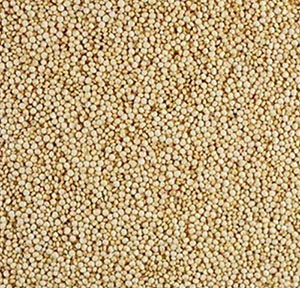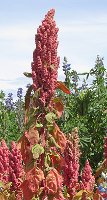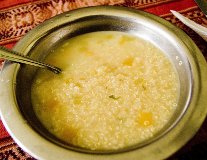Quinoa Nutrition Facts
Quinoa (pronounced as kinwah; quinua in Spanish) is an incredibly nutritious "grain-like seed" obtained from the goosefoot family plant native to the highland plains of the South American Andes region.
The ancient Incas believed quinoa was “the mother grain,” as eating it as food would confer upon them a long-lasting healthy life. The crop was once the staple food source of the Incas before the Spanish explorers forced them to abandon its cultivation.
Quinoa is a member of the goosefoot (Chenopodiaceae) family of annual herbs. White goosefoot (C. album) and Good King Henry (C. bonus-henricus) are some of the closely related species. Its scientific name is Chenopodium quinoa.
 |
| Quinoa seeds. Note oval, creamy-white seeds. |
Quinoa is indeed not a cereal group of staple grains. Instead, it is a "seed (legume)" in a way similar to other dicotyledons such as amaranth and legumes. Nonetheless, its seeds feature proportionately less fat content than oilseeds and beans and are hence treated similarly to other staple grains.
 |
| Chenopodium quinoa. Photo courtesy: mishmoshimoshi |
The quinoa plant reaches about 3-6 feet in height and prefers well-drained, neutral pH, and sandy soil. However, it can thrive in harsh environmental conditions and alkaline (salty) soils. For this reason, it has been cultivated as one of the chief crops in the rain-shadow highlands of Bolivia, Peru, Chile, and Ecuador since ancient times.
In its natural habitat, quinoa begins flowering (inflorescence) in July, which subsequently develops into edible seeds by the end of August through September.
Quinoa grains measure about two mm in diameter and can be white, gray, pink, or pale brown depending on the cultivar type. The seeds exhibit an outer seed coat composed of bitter substances known as saponins that should be removed before eating.
Quinoa has sparked renewed interest, especially among food scientists, due to its sustainable ability to thrive in challenging growing conditions. Moreover, its well-balanced protein, fat, and mineral composition offer potential solutions for alleviating malnutrition in famine-prone regions globally.
Health Benefits of Quinoa
100g of quinoa seeds (grains) contain 368 calories. Its grains are modest sources of energy, with a calorie content comparable to major cereals such as wheat, maize, rice, and pulses like chickpea, mung bean, and cowpea (black-eyed pea).
Quinoa grains contain 14-18g of protein per 100g. They comprise almost all essential amino acids required by the human body, particularly lysine, which is otherwise a limiting amino acid in grains like wheat, maize, and rice.
Quinoa is one of the gluten-free staple foods. Gluten, a protein present in certain grains from the grass family like wheat, may induce stomach upset and diarrhea in individuals with gluten sensitivity (Celiac disease).
The grains are a rich source of soluble and insoluble dietary fiber. 100g provides 7g or 18.5% of the daily fiber requirement. Dietary fiber increases food bulkiness, preventing constipation by speeding up its movement through the gut. It also binds to toxins, aiding in their excretion from the gut and protecting the colon mucosa from cancers.
Dietary fibers also bind to bile salts, decreasing their reabsorption in the colon, and helping lower serum LDL-cholesterol levels.
Quinoa grains are excellent sources of B-complex vitamins, vitamin E (α-tocopherol), and essential fatty acids such as linoleic and α-linolenic acid (18:3). 100g of grains contain 184 µg or 46% of the daily required levels of folates (B9).
Young, tender quinoa greens (leaves and shoots) and flower heads are excellent sources of vitamin A, folate, and antioxidants such as lutein, carotene, cryptoxanthin, and zeaxanthin. Yellow and red-type seeds are also rich in these pigment antioxidants. Together, these compounds function as powerful antioxidants, removing harmful free radicals from the body and protecting it from cancers, infections, aging, and degenerative neurological diseases.
Quinoa is an excellent source of minerals such as iron, copper, calcium, potassium, manganese, and magnesium. Copper is required for the production of red blood cells. Iron is essential for red blood cell formation. Magnesium relaxes blood vessels leading to the brain and has healing effects on depression and headaches. Zinc is a cofactor in many enzymes regulating growth, development, sperm generation, digestion, and nucleic acid synthesis. Potassium is an important component of cell and body fluids, helping control heart rate and blood pressure. The human body uses manganese as a cofactor for the potent antioxidant enzyme superoxide dismutase.
Quinoa is not a cereal grain but a dicotyledon seed (minute fruit) of the goosefoot plant. Nonetheless, it has been treated like grain and consumed as one of the staple sources along with potato and maize since ancient times by native Andean inhabitants.
It possesses all the characteristics of a seed and comprises essential amino acids, fats, starch, fiber, minerals, and vitamins in the right proportion.
Quinoa oil, extracted from its seeds, is an excellent source of essential fatty acids and vitamin E.
| Principle | Nutrient Value | Percent of RDA |
|---|---|---|
| Energy | 368 Kcal | 18.5% |
| Carbohydrates | 64.16 g | 49% |
| Protein | 14.12 g | 35% |
| Total Fat | 6.07 g | 20% |
| Cholesterol | 0 mg | 0% |
| Dietary Fiber | 7 g | 18.5% |
| Vitamins | ||
| Folates (B9) | 184 μg | 46% |
| Niacin (B3) | 1.520 mg | 9.5% |
| Riboflavin (B2) | 0.318 mg | 24% |
| Thiamin (B1) | 0.360 mg | 30% |
| Vitamin A | 14 IU | 0.5% |
| Vitamin E | 2.44 mg | 17% |
| Vitamin K | 0 | 0% |
| Electrolytes | ||
| Sodium | 5 mg | <1% |
| Potassium | 563 mg | 12% |
| Minerals | ||
| Calcium | 47 mg | 5% |
| Copper | 0.590 mg | 65.5% |
| Iron | 4.57 mg | 57% |
| Magnesium | 197 mg | 42% |
| Manganese | 2.003 mg | 87% |
| Phosphorus | 457 mg | 65% |
| Selenium | 8.5 μg | 15% |
| Zinc | 3.10 mg | 28% |
| Phyto-nutrients | ||
| Carotene-β | 8 μg | -- |
| Crypto-xanthin-β | 1 μg | -- |
| Lutein-zeaxanthin | 163 μg | -- |
Selection and Storage
Dry quinoa seeds, whether raw or processed, are readily available year-round in US stores. Since quinoa is not a conventional crop in the USA, it must be imported from Bolivia, Peru, and other South American countries. Processed seeds are typically sold in airtight packets and bulk bins.
Look for fine, dry grains roughly the size of pearl millet. They come in various colors, ranging from creamy-white, pink, yellow to deep brown, depending on the cultivar variety.
At home, store the grains in an airtight container in a cool, dry place to keep them fresh for several months. However, ground quinoa flour exposes its essential fatty acids to environmental factors, which can lead to rapid lipid peroxidation and reduce its shelf life. Therefore, grind it as needed and store the flour in an airtight container.
Preparation and serving methods

|
| Sopa de quinua- quinua soup. Photo courtesy: Robert Luna |
The unprocessed quinoa grain has a thick outer coat (hull) which makes it unsuitable for consumption and must be removed before cooking. saponin that imparts a bitter, soapy taste. Practically all quinoa grains available in US stores have been de-hulled and pre-washed.
At home, wash in cold water repeatedly until all of its foam disappears before cooking. Quinoa is cooked in the same way as you cook other staples like buckwheat, rice, etc. Roughly, one cup of dry grains cooks to three cups. Cooked quinoa becomes fluffy, and chewy and attains pearl-like translucency and a pleasant taste.
Here are some serving tips:
Combining quinoa flour with other cereal flours such as maize, wheat, oats, etc., enhances the overall protein quality of the meal, compensating for the limited amino acid levels in grains.
Traditionally, native Andeans used quinoa seeds to prepare porridge and soup, and they milled them into flour to make bread, porridge (lawa), buns, polenta, and non-alcoholic cold drinks (quinua chicha).
Elsewhere in the world, quinoa grains are used in various ways, similar to other cereal grains, to make pilaf, porridge, flakes, puddings, etc.
Its flour can be utilized in numerous ways to make bread, buns, cakes, pasta, noodles, cookies, biscuits, etc.
Young, tender quinoa leaves (chiwa) and flower heads are also consumed as leafy vegetables and indeed make good salads, stews, and soups when mixed with amaranth, spinach, and beet leaves.
Cold-pressed quinoa oil has become one of the sought-after as a dressing as well as a cooking oil, replacing rice bran or corn oils.
Safety Profile
Unpolished (unwashed) quinoa seeds contain saponin, a triterpenoid compound found in their outer cover. Saponin has a bitter, soap-like taste that, when consumed, may lead to stomach pain, flatulence, and laxative diarrhea. Naturally, this protective covering over the grains helps safeguard them from insects and birds.
Quinoa leaves and flower heads contain oxalic acid and should be blanched in boiling water before consumption. (Medical disclaimer).
≻≻- You may also like to read-
≻≻-What gluten-free food options are available for people with celiac disease?
≻≻-What grains have the lowest glycemic index?
≺≺ Back to Nuts and seeds from Quinoa. Visit here for an impressive list of nuts and seeds with complete illustrations of their nutrition facts and health benefits.
≺≺ Back to Home page.
Further Resources: